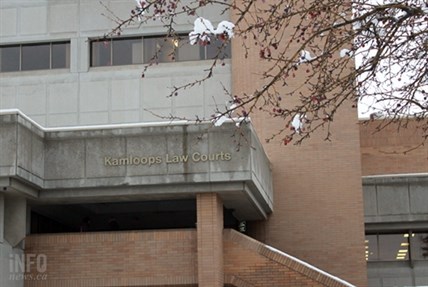
(GLYNN BROTHEN / iNFOnews.ca)
December 08, 2014 - 7:30 PM
KAMLOOPS – In their review of evidence, jurors will have to determine if Robert Donald Balbar’s testimony was genuine when he told them in a Kamloops Supreme Courtroom he killed his girlfriend Heather Hamill out of self-defence in 2003.
In Monday morning’s closing submissions on day 19 of Balbar's second-degree murder trial, the accused's lawyer Jim Blazina said his client had no choice but to hit Hamill after she allegedly threatened him and his sleeping eight-year-old son with an 18-inch-long machete. Hamill was high on a mixture of meth and alcohol – a dangerous combination for her, Balbar said. When he testified, Balbar told the court Hamill chased him around their one-bedroom apartment, cut his wrist with a knife and was “trying to take his head off” with the machete.
“At that point in time, he has a legal justification to assault her back,” Blazina said. “It’s what anyone would have done in that situation.”
He said psychologist Dr. Hugues Hervé identified him to be at a low-level of intelligence from a brain injury Balbar sustained in a car accident. The jury heard Balbar has a grade two level intelligence for math and a reading comprehension akin to a kindergartener. During trial, Balbar labelled a diagram of his apartment labelling door as “dore.”
Regarding the RCMP 'Mr. Big' sting which garnered a confession from Balbar, Blazina said his client made efforts to impress his new crew of friends who promised a ready supply of money, sex, accommodation and regular work. While he did confess to killing Hamill, Blazina said Balbar fabricated many of the elements involved in her death, particularly his statement that he struck her head between 50 to 60 times.
“It was a load of stories he made up,” Blazina said. He asked the jury to weigh the evidence carefully, as false confessions are possible in Mr. Big stings.
Meanwhile, Crown Prosecutor Iain Currie agreed Balbar made up parts of his confession to the crime boss, but said he lied under oath in both trials to weave a passable story jurors would sympathize with.
“On important issues, Mr. Balbar lied,” Currie said.
Under cross-examination, Currie asked Balbar how many blows were delivered to Hamill’s head suggesting Balbar knew most if not all were fatal.
“He knew it would kill her,” Currie said.
Court heard Balbar say he hit Hamill three to six times with a hammer, but Currie reminded him of a difference in testimony from the previous trial when he claimed to have hit her two to three times.
Eventually, Balbar changed his answer and told the court Hamill endured eight blows to the head. Dr. James Stephen, an experienced pathologist who conducted Hamill’s autopsy, said Hamill suffered nine head injuries.
“He told you just what he thought would match evidence,” Currie said. He mentioned Balbar never answered to where the alleged murder weapon - a mechanic’s hammer - was located.
Currie said Balbar did not prove that the cut to his wrist came from Hamill as he did not seek medical attention despite saying he bled more than her and told the court his cut healed completely within two weeks because his meth use quickened the healing process.
Currie said Balbar fully intended to cast Hamill’s body into the river and not give her a “traditional First Nations burial,” which he suggested in both trials. Balbar told jurors he packed a small garden shovel with him when he went to locate the cooler containing Hamill’s body he hid on the Kamloops Indian Reserve. Currie pointed out he never mentioned the shovel during his first trial.
“It made for a better story where he was more sympathetic,” Currie said. “He’s tailoring evidence that makes Mr. Balbar the hero of his own tale.”
The jury will begin deliberating its verdict Tuesday afternoon following directions from Justice Elizabeth Arnold-Bailey, the trial judge.
To contact a reporter for this story, email gbrothen@infonews.ca, or call 250-319-7494. To contact the editor, email mjones@infonews.ca or call 250-718-2724.
News from © iNFOnews, 2014